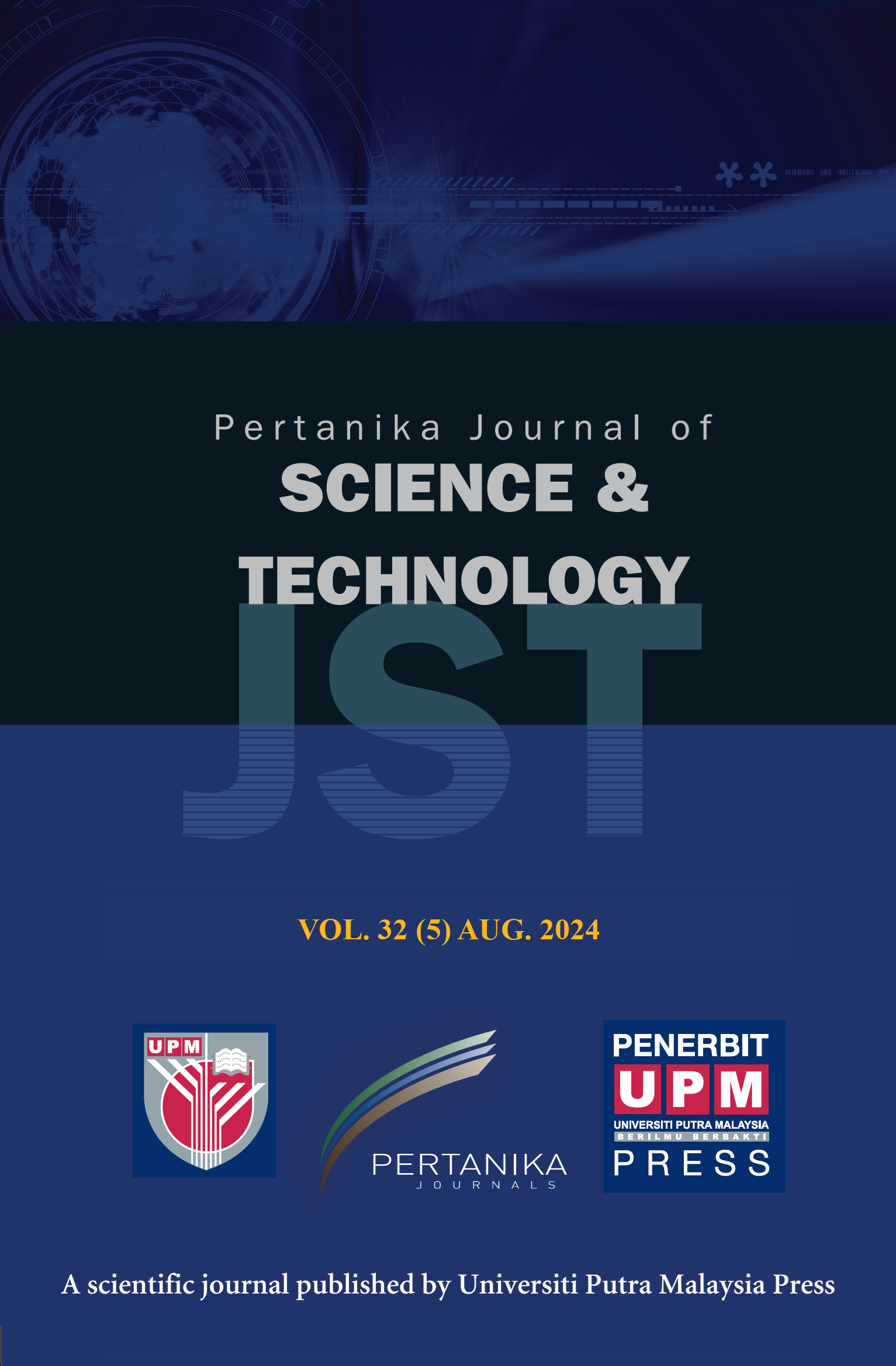PERTANIKA JOURNAL OF SCIENCE AND TECHNOLOGY
e-ISSN 2231-8526
ISSN 0128-7680
J
J
Pertanika Journal of Science & Technology, Volume J, Issue J, January J
Keywords: J
Published on: J
J
-
Bamdad, H., Papari, S., Lazarovits, G., & Berruti, F. (2022). Soil amendments for sustainable agriculture: Microbial organic fertilizers. Soil Use and Management, 38, 94-120. https://doi.org/10.1111/sum.12762
-
Chindaprasirt, P., Jaturapitakkul, C., & Sinsiri, T. (2007). Effect of fly ash fineness on microstructure of blended cement paste. Construction and Building Materials, 21(7), 1534-1541. https://doi.org/10.1016/j.conbuildmat.2005.12.024
-
Febria, F. A., & Rahayu, S. (2021). Development of local microorganism from organic waste as an alternative product for EM4. International Journal of Progressive Sciences and Technologies, 30(1), 98-105. https://doi.org/10.52155/ijpsat.v30.1.3755
-
Firdaus, R. B. R., Tan, M. L., Rahmat, S. R., & Gunaratne, M. S. (2020). Paddy, rice and food security in Malaysia: A review of climate change impacts. Cogent Social Sciences, 6(1), 1818373. https://doi.org/10.1080/23311886.2020.1818373
-
Jusoh, M. L. C., Manaf, L. A., & Latiff, P. A. (2013). Composting of rice straw with effective microorganisms (EM) and its influence on compost quality. Iranian Journal of Environmental Health Science and Engineering, 10, 17. https://doi.org/10.1186/1735-2746-10-17
-
Karki, G. (2020). Biofertilizer - Advantages, types, methods of application and disadvantages. Online Biology Notes. https://www.onlinebiologynotes.com/biofertilizer-advantages-types-methods-of-application-and-disadvantages/
-
Kornievskaya, E., Kurovsky, A., Babenko, A., Petrochenko, K., & Sechko, O. (2020). Microbial structure of nitrogen utilizers in Populus nigra L. compost and vermicompost. In IOP Conference Series: Earth and Environmental Science (Vol. 433, No. 1, p. 012001). IOP Publishing. https://doi.org/10.1088/1755-1315/433/1/012001
-
Milla, O. V., Rivera, E. B., Huang, W.-J., Chien, C.-C., & Wang, Y.-M. (2013). Agronomic properties and characterization of rice husk and wood biochars and their effect on the growth of water spinach in a field test. Journal of Soil Science and Plant Nutrition, 13(2), 251-266. https://doi.org/10.4067/S0718-95162013005000022
-
Molina-Favero, C., Creus, C. M., Simontacchi, M., Puntarulo, S., & Lamattina, L. (2008). Aerobic nitric oxide production by Azospirillum brasilense Sp245 and its influence on root architecture in tomato. Molecular Plant-Microbe Interactions, 21(7), 1001-1009. https://doi.org/10.1094/MPMI-21-7-1001
-
Paone, E., Fazzino, F., Pizzone, D. M., Scurria, A., Pagliaro, M., Ciriminna, R., & Calabrò, P. S. (2021). Towards the anchovy biorefinery: Biogas production from anchovy processing waste after fish oil extraction with biobased limonene. Sustainability, 13(5), 2428. https://doi.org/10.3390/su13052428
-
Pode, R. (2016). Potential applications of rice husk ash waste from rice husk biomass power plant. Renewable and Sustainable Energy Reviews, 53, 1468–1485. https://doi.org/10.1016/j.rser.2015.09.051
-
Ramli, N. H., Badrul Hisham, N. E., & Baharulrazi, N. (2023). The effectiveness of rice husk ash as additive in palm oil-based compost in enhancing the nitrogen uptake by Brassica oleracea var. alboglabra L. (Chinese kale) plant. Pertanika Journal of Tropical Agricultural Science, 46(1), 315-328. http://dx.doi.org/10.47836/pjtas.46.1.17
-
Romero-Perdomo, F., Camelo-Rusinque, M., Criollo-Campos, P., & Bonilla-Buitrago, R. (2015). Effect of temperature and pH on the biomass production of Azospirillum brasilense C16 isolated from Guinea grass. Pastos Y Forraje, 38(3), 231-233.
-
Sieuwerts, S., De Bok, F. A. M., Mols, E., De Vos, W. M., & Van Hylckama Vlieg, J. E. T. (2008). A simple and fast method for determining colony forming units. Letters in Applied Microbiology, 47(4), 275-278. https://doi.org/10.1111/j.1472-765X.2008.02417.x
-
Stoffella, P. J., & Kahn, B. A. (Eds.). (2001). Compost utilization in horticultural cropping system (1st ed.). CRC Press. https://doi.org/10.1201/9780367801236
-
Talaat, N. B. (2019). Effective microorganisms: An innovative tool for inducing common bean (Phaseolus vulgaris L.) salt-tolerance by regulating photosynthetic rate and endogenous phytohormones production. Sciencetia Horticulturae, 250, 254-265. https://doi.org/10.1016/j.scienta.2019.02.052
-
Unggang, J. A. F., Bakar, M. N., & Khair, A. B. A. (2023). The potential of several wild invasive fish species as fish-based organic fertilizers on the growth of two common vegetables in Malaysia. Sains Malaysiana, 52(1), 71-81. https://doi.org/10.17576/jsm-2023-5201-06
-
Wong, W. S., Tan, S. N., Ge, L., Chen, X., & Yong, J. W. H. (2015). The importance of phytohormones and microbes in biofertilizers. In D. Maheswari (Ed.), Bacterial metabolites in sustainable agroecosystem (pp. 105-158). Springer. https://doi.org/10.1007/978-3-319-24654-3_6
-
Yusof, M. S. M., Hajini, M. H., & Yusof, N. Y. (2022). Potential of fly larva and anchovy process waste powder as protein source in tilapia fish pellet. Politeknik and Kolej Komuniti Journal of Social Sciences and Humanities, 7(1), 49-55.
-
Zulfiqar, F., Navarro, M., Ashraf, M., Akram, N. A., & Munné-Bosch, S. (2019). Nanofertilizer use for sustainable agriculture: Advantages and limitations. Plant Science, 289, 110270. https://doi.org/10.1016/j.plantsci.2019.110270
ISSN 0128-7680
e-ISSN 2231-8526




